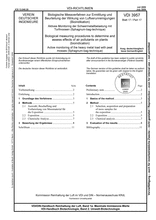
Technical rule [CURRENT]
VDI 3957 Blatt 17:2009-07
Biological measurement procedures to determine and assess effects of air pollutants on plants (bioindication) - Active monitoring of the heavy metal load with peat moss (Sphagnum-bag-technique)
- German title
- Biologische Messverfahren zur Ermittlung und Beurteilung der Wirkung von Luftverunreinigungen (Bioindikation) - Aktives Monitoring der Schwermetallbelastung mit Torfmoosen (Sphagnum-bag-technique)
- Publication date
- 2009-07
- Original language
- German, English
- Pages
- 11
- Publication date
- 2009-07
- Original language
- German, English
- Pages
- 11
Product information on this site:
Quick delivery via download or delivery service
Buy securely with a credit card or pay upon receipt of invoice
All transactions are encrypted
Short description
Increasing anthropogenic pollution of almost all ecosystems and the accompanying negative effects on plants, animals and humans led to extensive monitoring programmes for the continuous surveillance of the environment. An important aspect of the surveillance of the environment is the observation of heavy metal burdening. While some heavy metals, e.g. copper, manganese and zinc - within certain bounds of concentrations - are essential nutrients for plants, others e.g. lead, cadmium, chromium and mercury are toxic even in very small quantities. Besides conventional methods of ambient air monitoring based on physicochemical measurements, alternative methods using organisms as bioindicators for the surveillance of the environment are used more and more often. Because of their anatomical and physiological properties, bryophytes are better suited as bioindicators for heavy metal burdening than most phanerogams. These advantages of using bryophytes for biomonitoring are supported by many authors. There are two fundamental strategies of monitoring in biosurveillance: Passive monitoring: Examination of organisms which occur naturally in the investigation area. Active monitoring: Examination of organisms that were placed into the investigation area according to standardized procedures. The Sphagnum-bag-technique described in this guideline is a method of "active" biomonitoring.
Content
ICS
13.040.20
Also available in
Loading recommended items...
Loading recommended items...
Loading recommended items...
Loading recommended items...

